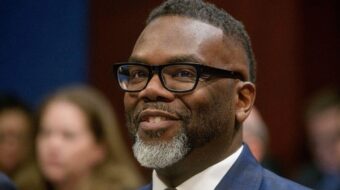Originally posted on
WASHINGTON, May 11 (Xinhua) — The U.S. space shuttle Atlantis lifted off Monday with seven-member crew onboard from Kennedy Space Center in Florida, on a mission to upgrade the 19-year-old Hubble Space Telescope for the last time.
The seven astronauts are commander Scott Altman, shuttle pilot Gregory C. Johnson and mission specialists Michael Good, Megan McArthur, John Grunsfeld, Michael Massimino and Andrew Feustel.
According to NASA TV, about two minutes and five seconds after liftoff, the twin solid rocket boosters assisting Atlantis’ launch into space have separated as planned from the shuttle’s external tank. The reusable boosters will fall back toward the Atlantic Ocean, where they will land under parachutes and be retrieved by recovery ships. They are equipped with cameras to record the performance of Atlantis’ external tank and any foam loss seen during its ascent.
Atlantis is expected to reach Hubble on Wednesday. Its 11-day mission is the final shuttle flight to Hubble.
The seven-member crew will enhance the observatory and ensure cutting-edge science. The mission will put in place advanced technology that improves the telescope’s discovery power by 10 to 70 times. Five spacewalks are planned to install new instruments and thermal blankets, repair two existing instruments, refurbish subsystems and replace gyroscopes, batteries and a unit that stores and transmits science data to Earth. The result will be six working, complementary science instruments with new capabilities, and an extended operational lifespan through at least 2014.
When Atlantis was on its way to Hubble, space shuttle Endeavor was prepared as a backup vehicle for Atlantis. Endeavor will also be launched if in the unlikely event that it’s needed for a rescue flight.
That’s because Atlantis’ 11-day mission comes with a higher risk than usual. Atlantis will be flying in an unusually high orbit for a space shuttle — 350 miles up. Space is more littered there with spacecraft parts, and the odds of a catastrophic strike are greater.
Scientists estimated that there’s a slightly higher risk of damage from the orbital debris — about a 1-in-229 chance of a critical strike. To offset that, NASA plans to fly Atlantis down to a safer orbit just after releasing Hubble back into space near the end of the flight.
Hubble, launched by NASA in 1990, was named after U.S. astronomer Edwin Hubble whose work revolutionized our understanding of the size and structure of the universe. After its first two months of tests in 1990, the initial images from Hubble were a blurry disappointment. A slight flaw in the telescope’s main mirror — barely the width of a human hair — fouled the observatory’s vision.
In 1993, NASA sent a shuttle up to Hubble, where astronauts added corrective lenses — essentially glasses — to sharpen its vision. The result was crystal clear: 16 years of stunning cosmic photos followed.
Since that first orbital fix, astronauts returned to Hubble three more times; in 1997, 1999 and 2002.
Hubble has given the world amazing insight into the origins of our universe. Among its greatest discoveries are determining the age of the universe (13.7 billion years); finding that virtually all major galaxies have black holes at their center; discovering that the process of planetary formation is relatively common; detecting first ever organic molecule in the atmosphere of a planet orbiting another star; and providing evidence that the speed at which the universe is expanding is accelerating — caused by an unknown force that makes up more than 75 percent of the universe.
Tweets from space: Follow Mike Massimino on Twitter:









